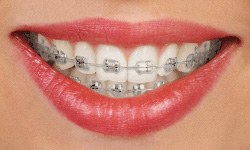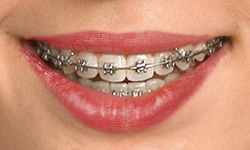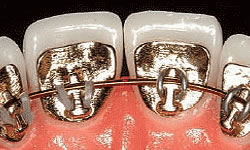For most people, achieving a healthy, beautiful smile is the reason for choosing to receive orthodontic care. If you’re self-conscious about your smile, having braces will greatly improve the way you look and feel.
When your treatment is complete, you will have the smile you’ve always dreamed of as well as the confidence to show it off! We also want you to feel comfortable and confident throughout your entire orthodontic experience, so our practice is dedicated to making sure that you receive the quality care you deserve.
How Orthodontic Treatment Works
Orthodontic appliances are made of metal, ceramic, or plastic. They may be removable or they may be brackets bonded to the teeth. By placing a constant, gentle force in a carefully controlled direction, braces slowly move teeth to the proper position.
Gone are the days when a metal band with a bracket was placed around each tooth. You can now choose brackets that are clear or metallic, and in some cases, choose the color of your appliance. Wires are far less noticeable, and the latest materials are designed to move teeth faster with more comfort. Today, any age is a great age to wear braces!
Duration Of Treatment
Depending on several factors, including age, treatment method, and how minor or severe your case is, treatment time varies and can last between one and three years. For children, receiving interceptive, or early treatment, can also help provide a quicker treatment time later on in life. A big factor to a successful treatment is you, the patient! The more involved and diligent you are, the quicker and more efficient your treatment will be.
Before beginning your orthodontic care, your doctor will discuss all of your options and provide an estimate for how long your full treatment may take. Please contact our practice to schedule an appointment and learn more about orthodontics and the treatments we provide.
Types Of Braces
Traditional Metal Braces

Traditional metal braces are the most common type of braces and are more comfortable today than ever before. Made of high-grade stainless steel, metal braces straighten your teeth by using metal brackets and archwires. With metal braces, you have the option of adding colored elastics (rubber bands) for a more unique and colorful smile.
Self-ligating Braces

Self-ligating braces are made from the same materials as traditional braces; however, self-ligating braces do not require the use of elastics, meaning fewer appointments and less friction being placed on the tooth. Self-ligating braces come with traditional metal, ceramic, or clear brackets. They are the same size as metal braces, but they use a specialized clip in place of elastics to help the archwire guide teeth into place. The clip helps reduce the amount of pressure being placed on the tooth and requires fewer adjustments because there are no elastics to replace.
Clear (Ceramic) Braces

Ceramic braces are made of clear materials and are therefore less visible on your teeth than metal braces. For this reason, ceramic braces are used mainly on older teenagers and adult patients who have cosmetic concerns. While they are visually less prominent, they do require more attention to oral hygiene, as ceramic braces are larger and more brittle than their metal counterparts. For these reasons, ceramic braces tend to be used more on upper front teeth rather than on lower teeth.
Clear Aligners

Clear aligners are a series of invisible, removable, and comfortable acrylic trays that straighten your teeth like braces. Not only are the aligners invisible, they are also removable, allowing you to eat and drink what you want while in treatment. Plus, this helps to make brushing and flossing less of a hassle. The aligners are comfortable and have no metal to cause mouth abrasions during treatment.
Gold Braces

Gold braces are similar to traditional metal braces. Like traditional metal braces, gold braces are made of stainless steel; however, they are coated in gold. The gold coating may be considered a more cosmetic option than traditional metal braces. And, the cost of gold braces is surprisingly comparable to most clear braces.
Lingual Braces

Lingual braces are hidden behind the teeth and are therefore “invisible” when you smile. Lingual braces are 100% customized to match the shape of your teeth. Lingual braces are a very reasonable option for athletes, models, actors/actresses, musicians who play wind instruments, and adult professionals.
Orthodontics is a specialized field of dentistry that focuses on diagnosing, preventing, and correcting dental and facial irregularities, primarily concerning the alignment of teeth and jaws. If you’ve ever considered improving your smile or wondered about braces, this comprehensive guide to orthodontics will provide you with valuable insights into this fascinating branch of dentistry.
What Is Orthodontics?
Orthodontics is a branch of dentistry that deals with correcting misaligned teeth and jaws to improve oral health, function, and aesthetics. Orthodontists are dental specialists who undergo additional training beyond dental school to become experts in diagnosing and treating orthodontic issues.
Common Concerns Addressed By Orthodontics
Orthodontic problems can occur due to various factors, including genetics, early childhood habits, or trauma. Some common orthodontic issues include:
- Crowding: When there isn’t enough space in the jaw for all the teeth to fit properly, they may become crowded or overlapped.
- Spacing: Gaps or spaces between teeth can occur due to missing teeth, small teeth, or abnormal growth of the jaw.
- Overbite: An overbite occurs when the upper front teeth overlap significantly with the lower front teeth.
- Underbite: An underbite occurs when the lower front teeth protrude past the upper front teeth.
- Crossbite: A crossbite occurs when some of the upper teeth fit inside the lower teeth when biting down.
- Open Bite: An open bite occurs when the upper and lower front teeth do not overlap when biting down, leaving a gap between them.
Benefits Of Orthodontic Treatment
Orthodontic treatment offers numerous benefits beyond just a straighter smile. Some of the key benefits include:
- Improved Oral Health: Straighter teeth are easier to clean and maintain, reducing the risk of tooth decay, gum disease, and other oral health problems.
- Enhanced Function: Properly aligned teeth and jaws improve bite function, making it easier to chew, speak, and perform daily activities.
- Increased Confidence: A beautiful smile can boost self-confidence and improve overall well-being, leading to a happier, more fulfilling life.
- Prevention Of Dental Issues: Orthodontic treatment can prevent or reduce the severity of dental issues such as tooth wear, TMJ disorders, and speech problems.
- Long-Term Stability: Orthodontic treatment aims to create a stable, functional bite that lasts a lifetime, reducing the risk of relapse or future orthodontic problems.
Orthodontic Treatment Process
- Initial Consultation: During the initial consultation, the orthodontist evaluates the patient’s dental and facial structure, takes X-rays and photographs, and discusses treatment options and goals.
- Treatment Planning: Based on the evaluation, the orthodontist creates a customized treatment plan tailored to the patient’s needs and preferences.
- Appliance Placement: Depending on the chosen treatment option, the orthodontist places braces, clear aligners, or other orthodontic appliances on the teeth.
- Adjustments And Monitoring: Throughout the treatment process, the orthodontist makes periodic adjustments to the appliances to gradually move the teeth into proper alignment. Regular check-ups and monitoring are essential to track progress and make any necessary modifications to the treatment plan.
- Retention: Once the desired results are achieved, the patient wears a retainer to maintain the new position of the teeth and prevent them from shifting back.
Six Options For Your Orthodontic Journey
Orthodontic treatment has come a long way, offering a variety of options to address misaligned teeth and jaws. At Dentistry for Children and Young Adults, we understand the importance of providing personalized orthodontic care to meet the diverse needs and preferences of our patients, and offer six different orthodontic treatment options, including clear aligners and lingual braces.
Choosing The Right Treatment For You
With so many orthodontic options available, choosing the right treatment can seem overwhelming. Here are some factors to consider when selecting the best option for you:
- Treatment Goals: Discuss your treatment goals and expectations with your orthodontist to determine which option aligns best with your needs.
- Aesthetic Concerns: Consider how visible you want your braces to be and whether you prefer a discreet or more noticeable treatment option.
- Lifestyle Factors: Think about your lifestyle and how different treatment options may impact daily activities such as eating, speaking, and oral hygiene.
- Treatment Duration: Some orthodontic treatments may offer faster results than others, so consider your desired treatment timeline.
- Cost And Insurance Coverage: Inquire about the cost of treatment and whether your insurance plan covers orthodontic care.
Which Is Best For Me?
At Dentistry for Children and Young Adults, we are committed to providing high-quality orthodontic care tailored to your individual needs. Whether you’re considering traditional metal braces, clear aligners, or any of our other orthodontic options, our experienced team is here to help you achieve a straighter, healthier smile. Call 408-226-0323 and schedule a consultation with us today to explore your orthodontic options and take the first step toward a confident, beautiful smile that lasts a lifetime.
